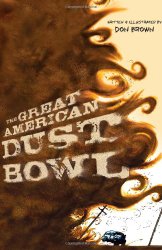
 The Great American Dust Bowl
The Great American Dust BowlHoughton Mifflin Harcourt, 2013. 80 pages.
Starred Review
2014 Sonderbooks Stand-out: #5 Children's Nonfiction
When I see a history book for kids presented in comic book form, full of facts and graphic details, I think, “Goodness! Why don’t they all do it this way?” I can’t call it a graphic novel, but it’s a graphic history book. It’s in comic book form and doesn’t only tell you what the Dust Bowl was like, it also shows you.
I’ve heard a lot about the dust bowl. But now, with the aid of these pictures, I feel like I know what it was like to experience it.
Don Brown gives us an overarching view, even giving the factors that built up to it, but he also focuses in on the experiences of people. He shows how small people and cars and telephone poles were compared to the clouds of dust. The page about bugs has quite a gross-out factor:
Bugs that should have died in colder, wetter weather or been eaten by birds and bats killed by the drought now turned up everywhere. Centipedes crawled across ceilings and walls, tarantulas marched across kitchens, and black widow spiders lurked in corncribs and woodsheds.
“The ants were so thick and so bad that you could swipe handfuls of them off the table and still have more ants on the table.”
The picture with that shows the woman who is speaking looking askance at a table covered with ants.
There’s a dramatic page, mostly filled with a dust cloud, dwarfing a car and telephone poles. The words written in wavy lines across the cloud say:
Storms could blow for days and be immediately followed by another and another, making for unrelenting blows for weeks on end.
Raging, grit-filled winds shattered windows and scoured the paint off houses and cars.
Trains derailed. Telephone poles were knocked to the ground.
Altogether, Don Brown gives readers vivid detail about the Dust Bowl, and they understand some of the causes and the scope of the problem. (I had never realized before that during that time, even New York City got hit with a dust storm that made lights necessary during daylight hours.) They even have some warnings that it could happen again.
The book is artistic as well. If you leaf through the pages, you notice right away that Don Brown has used different panel arrangements on each set of pages, and keeps the story varied and interesting.
This is history that will stick with you.
